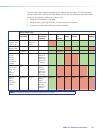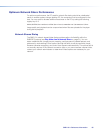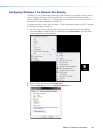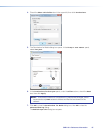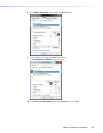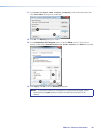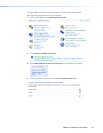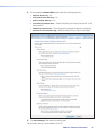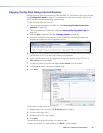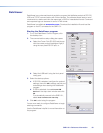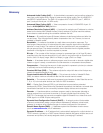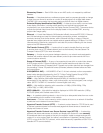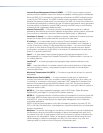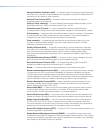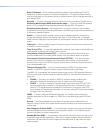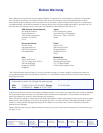
Network Address Translation (NAT) — A network protocol that allows multiple devices to
have their own, individual, private addresses, but they share one public IP address (IPv4) for
connection to the internet or other networks.
Network Time Protocol (NTP) — A protocol used for synchronizing the clocks of
computer systems over networks.
Parity (or Parity checking) — An error detection technique that tests the integrity of the
digital data being sent. Parity can be set to None, Even, or Odd.
Predictive frame (P-frame) — In video compression schemes, predictive frames
(P-frames) follow I-frames and contain data that has changed from the preceding I-frame.
Pull streaming — Streaming method that allows users to search for content. Users specify
a content source and initiate a download or view the stream. The content streaming is
initiated by the end user (at the decoder rather than at the encoder).
Push streaming — A streaming method where the encoder sends content out to one
(unicast) or more (multicast) decoders using one of the transport protocols. Content
streaming is initiated at the encoder.
Quality of Service (QoS) — The grade of performance, such as transmission rates and
error rates, of a communications channel or system. QoS provides a level of predictability
and control beyond the best-effort delivery that the router provides by default (best-
effort service provides packet transmission with no assurance of reliability, delay, jitter, or
throughput).
Real-time Streaming Protocol (RTSP) — A network control protocol designed for use in
audio visual and communications systems to control streaming media.
Real-time Transport Protocol (RTP) — An Internet Engineering Task Force (IETF)
standard for streaming real-time multimedia over IP in packets.
Router — A network device that forwards packets from one network to another.
Session Announcement Protocol (SAP) — Used by source devices (encoders or servers)
in conjunction with SDP to publicize the availability of a stream to decoders and players.
The SAP periodically broadcasts session description information on an industry standard
multicast address and port. When received by remote clients, these announcements can be
used to facilitate the viewing of streams, eliminating the need for user configuration.
Session Description Protocol (SDP) — Used to describe multimedia sessions for the
purposes of session announcement, session invitation, and other forms of multimedia
session initiation (as defined in RFC 2327).
Secure Shell (SSH) — A network protocol that creates a secure channel used for secure
communication between two computers on a network. SSH is typically used for data
communication, remote shell (login) services, or command execution.
Secure Sockets Layer (SSL) — A protocol used by web servers and web browsers that
creates a uniquely encrypted channel for private communications over the public Internet.
Simple Instruction Set (SIS) — A set of commands developed by Extron that allows for
RS-232, USB, and TCP / IP control of certain Extron products. A command is sent from
the control device to the product (using a minimal number of characters) and a response is
received from the product and shown on the display of the control device.
Secure File Transfer Protocol (SFTP) — Similar to FTP, this protocol adds encryption and
requires credentials for file transfers.
Simple Network Management Protocol (SNMP) — An application-layer protocol that
facilitates the exchange of management information between network devices. This protocol
collects (and configures) information from network devices (such as servers, hubs, switches,
and routers) on an Internet Protocol (IP) network.
SMD101 • Reference Information 97



